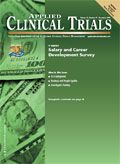The GXP Training Guidelines: Raising Standards Through Competence-Based Training
Applied Clinical Trials
There is currently no set of standards for how individuals acquire the ability to perform satisfactorily and demonstrate the required levels of competence.
Many industries have training standards such as the automotive sector, the renewable energy industry, and specialist areas such as forklift truck driving. In the field of clinical research, guidelines and regulations such as the ICH Harmonized Tripartite Guideline—Guideline for Good Clinical Practice E6(R1) make very general references to training. "Each individual involved in conducting a trial should be qualified by education, training, and experience to perform his or her respective task(s)" (ICH GCP principle 2.8). However there is currently no set of standards for how individuals acquire the ability to perform satisfactorily and demonstrate the required levels of competence.

The guidelines were designed to share best training practices for anyone involved in the training and development of clinical research professionals. (Source: Getty Images)
In response, the International Academy of Clinical Research (IAoCR) set up a taskforce to produce GXP training guidelines. The aim of these guidelines is to share best training practices for anyone involved in the training and development of clinical research professionals. The guidelines are designed for use in any organization no matter what size, both in the non-commercial and commercial sectors.
The guidelines cover the key steps in developing competent individuals, starting with creating a competency framework, through to the assessment of learning and its documentation. The overriding theme of the guidelines is how to use various learning interventions to achieve learner competence. Having competent individuals is vital in clinical research for protecting the rights and well-being of patients and securing verifiable and accurate data. A further benefit is that new treatments for patients can be developed without unnecessary delays or costs due to errors and rework because of incompetence.
By using the guidelines, organizations can demonstrate a real investment in their people, which leads to other advantages such as increased staff retention and a sound basis for promotions and succession planning.
The taskforce that created the guidelines was made up of five clinical research professionals from various backgrounds and organizations, and represented Europe, the Americas, and the Indian sub-continent. After some additional input from the IAoCR, the first draft of the guidelines was circulated for consultation to approximately 40 organizations worldwide involved in clinical research and included universities and not-for-profit professional bodies. Following refinement from this initial consultation, a second round of opinion was sought from over 200 individuals working in all sectors of the international clinical research community. The guidelines were finalized and released in mid-November.
The content of the guidelines covers how to:
- Define competencies for job roles
- Conduct a learning needs analysis
- Select trainers
- Design and deliver learning interventions
- Assess the effectiveness of the interventions
- Gather learners' feedback
- Manage the documentation
In addition, there is a set of appendices containing examples, templates, and a reading list for those who want a more in-depth coverage of any of the topics.
Initial reaction has been very positive. The hope is to see universal take-up of the guidelines in developing competent individuals for the benefit of clinical research worldwide.
—Martin Robinson, PhD, Principal Director, International Academy of Clinical Research Ltd

Including Women of Childbearing Age in Clinical Research
March 26th 2024In recognition of International Women's Month, we're featuring this recent talk between Associate Editor Miranda Schmalfuhs and Marie Teil, Global Head of UCB’s Women of Childbearing Age Program. They speak about the specific challenges women with chronic illnesses face when accessing appropriate treatment and participating in clinical trials, UCB's Women of Childbearing Age Program and it’s most successful strategies, and much more.
Improving Engagement While Maintaining Data Integrity & Validity
March 19th 2024In recognition of Women's Health Month, we're featuring this recent talk between Associate Editor Miranda Schmalfuhs and uMotif's Chief Product Officer, Julia Lakeland, discuss new technologies improving patient engagement and reducing the emotional and logistical burdens of participation, ethical considerations that should be addressed when implementing those technologies, while ensuring patient privacy, and much more.